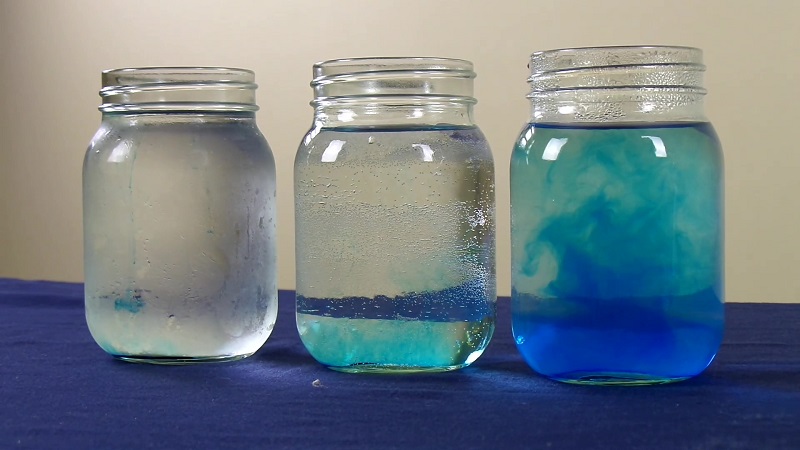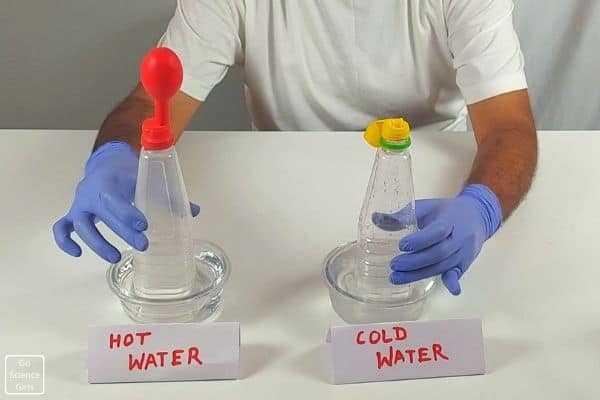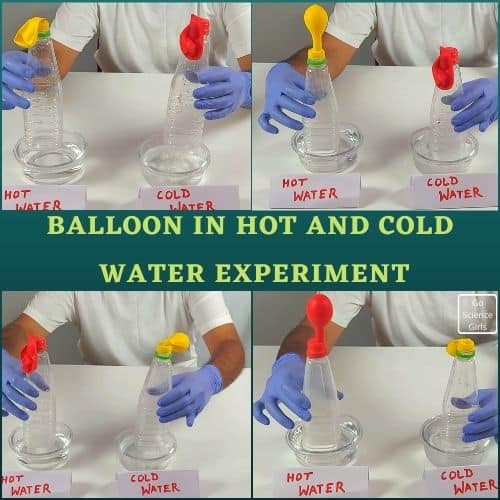Describe an Experiment Using Only Hot and Cold Water
Drop a few drops of food coloring in each cup. A biology experiment requires the preparation of a water bath at 370C body temperature.

How To Demonstrate Diffusion Using Water Stem Little Explorers
Using your tape and marker label one container water and the other salt water In your salt water container dissolve 15 teaspoons of salt for every cup of water so if you have two cups use 3 teaspoons.

. If you were to have 2 cups of water one of hot water and one of cold water with equal volumes the cold water would have more molecules. A convection current may have been setup in the warmer water. Let the plate-covered jar sit there for a minute or two then dump a tray of ice cubes on the plate.
The cold blue water stays on. When the drain of the washtub is open it will drain completely in 7 minutes. Describe an experiment using only hot and cold water that would allow you to verify that the heat capacity of your coffee-cup calorimeter is about 10 x 101.
It will rain inside the jar. Mass of cold water m2. Be specific about the procedure you would follow and the calculations you would need to perform.
When the cold water is on the bottom the hot water doesnt have to rise--its already on top. For the room temperature water fill. 1- Bring three pails of waterone cold one at room temperature and one hot.
Describe in detail an experiment using only hot and cold water that would enable you to verify that the heat capacity of your coffee cup calorimeter is about 1010 jC. - Warm water NOTE - be careful not to make the water too hot - Cold water with a few ice cubes in it - Medium temperature water. Up to 64 cash back Pour the hot water into the big glass jar and cover it with a dinner plate.
If a student starts with 700 g of. Step 1 Begin by preparing three identical jars of water. Water Temperature Science Experiment Instructions.
Hot And Cold Water Science Experiment. In one glass pour the cold water and in the other hot water. Each molecule has one oxygen and two.
Initial temperature cold water and calorimeter t1. Mass of calorimeter m3. In this experiment you can visualize the difference in density between hot and cold water.
Hot and Cold Water Psychological Experiment. So hot water is less dense than cold water. Do not put any ice in the cold water cup.
So hot water takes up more space than cold water. Describe an experiment using only hot and cold water that would allow you to verify that the heat capacity of your coffee-cup calorimeter is about 10 x 101 JC. For cold water fill the jar and put it in the fridge for an hour or two.
Describe an experiment using only hot and cold water that would allow you to verify that the heat capacity of your coffee-cup calorimeter is about 10 x 101 JC. Hot Cold Water Science Experiment HooplaKidzLab. Fill one jar with cold water one jar with room temperature water and one jar with hot water.
Fill Cup 1 with 100 ml of cold water about 10 C and Cup 2 with 150 ml of warm water about 50 C. If both the hot and cold. Chemistry questions and answers.
Mass of hot water m1. Final temperature of mixture t2. The temperature of the cold tap water is 220C and the temperature of the hot tap water is 550C.
When you put the two together with the hot water on the bottom the hot water rises to the top mixing with the cold water along the way and creating purple water. Place the bottle in the pan with the hot water. The ice on the plate will make the plate very cold which causes the warm air in the jar to condense and form water droplets.
Heat capacity of calorimeter. The amount of space something takes up is called volume. You Will Be Surprised of The Results.
2 - Put one hand into the warm water and one in the iced water for one minute. How to do the experiment. 3- Then place both hands in the room-temperature water simultaneously.
Turn the CBL into a thermometer by selecting MODE. This experiment by HooplaKidzLab demonstrates how the more dense cold water sinks those molecules are. Up to 24 cash back Describe an experiment using only hot and cold water that would enable you to verify that the heat capacity of your coffee-cup calorimeter is about 10 x 101 JOC.
Take 2 transparent glasses and fill them with the water. 1 - Fill one bowl with warm water one with iced water and one with medium water. Turn ON the CBL unit and plug the TI temperature probe into channel one.
Hot and cold water are made of the same type of molecules. Instructions for a fun experiment to teach the difference between the density of hot water and the density of cold wat. Heat gained by calorimeter and cold water heat lost by hot water.
Describe an experiment using only hot and cold water that would enable you to. Why doesnt the water mix when the hot water is on top. Describe an experiment using only hot and cold water that would allow you to verify that the heat capacity of a coffee-cup calorimeter is about 10 eqtimes 10-1 eq Jeqo eqC.
Put the containers in a freezer this will take at few hours to freeze best done overnight and keep frozen until ready to perform. 3-4 drops are enough and you should not put too much food color. Using the food coloring and a thermal infrared camera you can re.
As the initially warmer water cools to the freezer temperature it may lose significant amounts of water to evaporation. The reduced mass will make it easier for the warmer water to cool and freeze than the colder water. Fill one pan with ice and cold water.
With two matching jars red and blue food coloring some hot and cold water an index card and a dish or baking pan you can observe how the different densities of hot and cold water behave. When only the hot water valve is opened the washtub will fill in 12 mintues. As we mentioned near-boiling water for hot and regular temperature water from the pipe will be good to demonstrate the diffusion.
2- Place one hand in the cold water and one in the hot water. Heat capacity of water w. Heat capacity of the calorimeter is calculated using the formula.
When only the cold water valve is opened a washtub will fill in 8 minutes. This experiment is done in three easy steps. When you heat up water the water molecules start moving around faster and faster.

Water Temperature Science Experiment

Balloon In Hot And Cold Water Experiment


0 Response to "Describe an Experiment Using Only Hot and Cold Water"
Post a Comment